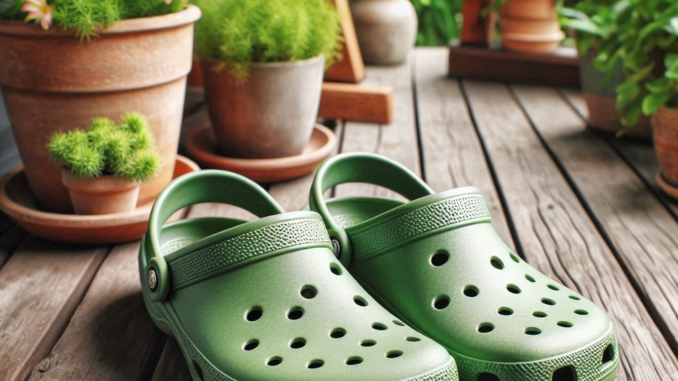
Do Crocs Have Nutritional Value?
Hey there, shoe lovers and curious minds! Ever wonder if those comfy Crocs on your feet could double as a snack? It’s a wild thought, right? Well, buckle up as we dive into this wacky world where fashion meets… food? Let’s unpack this quirky question and see what’s really going on with our favorite foam clogs.
Quick Answer
Nope, Crocs don’t have any nutritional value. They’re made of synthetic stuff that’s great for your feet but terrible for your tummy. Don’t try to eat them!
What Are Crocs Really Made Of?
Alright, let’s break it down. Crocs are made of this special stuff called Croslite. It’s not your average shoe material. Think of it like a superhero foam – it’s comfy, it floats, and it fights off stinky feet like a champ. But here’s the kicker: it’s 100% man-made. We’re talking oil-based, not food-based. So right off the bat, we can see why Crocs aren’t exactly menu material.
The Science Behind Croslite
Croslite is what scientists call a closed-cell resin. In simple terms, it’s like a bunch of tiny bubbles all squished together. This is why Crocs are so light and comfy. But these bubbles are made of stuff that comes from oil, not from anything you’d find in your kitchen. There’s no protein, no vitamins, no minerals – none of the good stuff your body needs from food.
Can You Actually Eat Crocs?
Let’s get real for a second. Could you physically put a piece of Croc in your mouth and chew it? Sure. Should you? Absolutely not! Your body isn’t built to handle this kind of material. It’s like trying to eat a plastic bag – it’s just not going to end well.
What Happens If You Eat Crocs?
If you did try to eat a Croc (please don’t), here’s what might happen:
- You could choke – these things aren’t exactly easy to swallow
- Your stomach would get super confused and probably upset
- The chemicals in Croslite could make you sick
- You might end up needing to see a doctor
The Croc vs. Croc Confusion
Now, here’s where things get a bit funny. Some folks might hear “eating Crocs” and think we’re talking about crocodiles. And that’s a whole different story! Crocodile meat is actually eaten in some parts of the world. It’s got protein and all that good stuff. But the Crocs we’re talking about? They’re just shoes, folks!
A Tale of Two Crocs
| Croc (Shoe) | Croc (Animal) |
|---|---|
| Made of foam | Made of… well, crocodile |
| Zero nutritional value | High in protein |
| Great for walking | Great for… swimming? |
| Comes in fun colors | Usually just green |
The Internet’s Obsession with Eating Weird Stuff
So why are we even talking about eating Crocs? Well, the internet is a wild place. People come up with the craziest ideas, and sometimes they go viral. There have been videos of people pretending to cook Crocs, fry them, even blend them into smoothies. It’s all for show, folks. Don’t believe everything you see online!
A Personal Close Call
“I remember when my buddy Jake saw one of those viral videos. He thought it’d be hilarious to try ‘Croc soup’ for his cooking channel. I had to sit him down and say, ‘Dude, your channel’s great, but let’s keep the Crocs on our feet, okay?’ We had a good laugh about it, and he ended up making actual chicken soup instead. Crisis averted!”
The Real Deal on Shoe Materials
Let’s take a step back and look at what shoes are really made of. Most shoes aren’t edible, and that’s a good thing! They’re designed to protect our feet, not feed us. Here’s a quick rundown of some common shoe materials:
- Leather: Comes from animals, but tanned leather isn’t food
- Rubber: Great for soles, terrible for snacking
- Canvas: Made from cotton or linen, but processed for durability
- Synthetic materials: Like our friend Croslite, these are man-made and not for eating
The Importance of Food Safety
All this talk about not eating shoes might seem silly, but it brings up a good point about food safety. It’s super important to know what’s safe to eat and what’s not. Here are some quick tips:
- If it’s not sold as food, don’t eat it
- Check expiration dates on your food
- Wash fruits and veggies before eating
- Cook meat thoroughly
- When in doubt, ask an adult or expert
The Real Nutritional Heroes
Instead of wondering about eating Crocs, let’s talk about some foods that are actually good for you! These are the real nutritional superstars:
- Fruits and vegetables: Packed with vitamins and fiber
- Lean meats and fish: Great sources of protein
- Whole grains: Give you energy and more fiber
- Nuts and seeds: Full of healthy fats and minerals
- Dairy or dairy alternatives: Calcium for strong bones
Crocs: Better for Your Feet Than Your Belly
So, we’ve figured out that Crocs aren’t food. But they’re still pretty awesome! Here’s why people love them:
- They’re super comfy
- Easy to clean – just wipe them down
- They come in tons of fun colors and styles
- Great for the beach or pool because they’re waterproof
- Doctors even wear them in hospitals because they’re so comfy for long shifts
Wrapping It Up: Crocs Are Not Food!
Alright, let’s bring it home. Crocs might look a bit like Swiss cheese, but they’re definitely not for eating. They’re shoes, plain and simple. They’re great for keeping your feet comfy and dry, but they won’t do anything for your hunger.
Remember, folks:
- Crocs = awesome shoes
- Crocs ≠ food
Next time you slip on your favorite pair of Crocs, give them a little pat and say, “Thanks for being such great shoes.” And then go grab a real snack if you’re hungry!
Now that we’ve cleared up this wacky question, why not learn more about actual nutrition? There’s a whole world of amazing, edible stuff out there waiting for you to discover. And hey, maybe next time you’re munching on a healthy snack, you can do it while wearing your comfy Crocs. Best of both worlds, right?
Stay curious, stay safe, and keep those Crocs where they belong – on your feet!


Leave a Reply